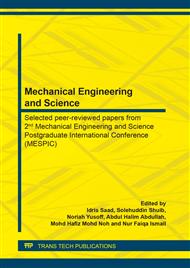p.11
p.22
p.31
p.42
p.50
p.61
p.73
p.81
p.94
Design and Development of Actuator System for Automated Polypropylene Bag Assembly Machine
Abstract:
Polypropylene bags are widely used in many industries especially in agriculture and food industry. However, industries especially in food or fertilizer industries, need to use the polypropylene bags that can withstand a high level of humidity. To overcome this problem, a two-layers bag is required. This two-layers bag consists of outer layer woven bag and inner layer polypropylene bag. Currently they are produced by using conventional method where they are assembled manually by the workers. This manual method causes longer production time process, a high number of workers, and higher cost for mass production. To enhance the operation performance, automated polypropylene bags assembly system is proposed. By using an automated system, it can improve quality and consistency of processes, and reduced direct human labor costs and expenses where the worker is unneeded for assembling the polypropylene bag. To overcome this problem, this project is dedicated to design and develop a new Automated Polypropylene Bag Assembly Machine (APBAM) to operate the process automatically. This machine will execute three main processes - Grasping, Handling and Feeding. This paper will focus on the design of pneumatic actuator for grasping polypropylene bags in upward and downward motion. The design will be calibrated, analyzed and evaluated. The design of automated polypropylene bags assembly system will help to solve some of the problems that have been identified.
Info:
Periodical:
Pages:
50-60
Citation:
Online since:
June 2020
Keywords:
Price:
Сopyright:
© 2020 Trans Tech Publications Ltd. All Rights Reserved
Share:
Citation:


